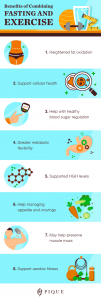It’s no secret that intermittent fasting is fantastic for your health. And the same is true for exercise.
But what about intermittent fasting combined with exercise?
“Fasted cardio” is a controversial topic, and one on which the health and fitness world is divided.
However, as is the case with many debates, people tend to miss the nuances of blending intermittent fasting with exercise.
Starving yourself and spending hours at a time on the treadmill doesn’t fit anyone’s definition of healthy–but what about less-extreme approaches?
Today, we’re going to take a holistic look at the benefits of fasting and exercise, with particular emphasis on what happens when you combine these healthy practices.
Keep reading to learn the pros and cons of exercising in the fasted state, how different types of exercise fit into your fasting regimen, and the best ways to incorporate fasted exercise for your health and wellness.
Is Fasted Exercise Safe? A Good Idea?
First, let’s address the controversy.
Scientists, researchers, and coaches continue to debate the merits of fasted exercise for weight loss. And scientific studies find conflicting results in that regard–suffice to say that the jury is still out (1)(2).
However, for the purposes of this article, we’re investigating the safety and health benefits of fasted exercise.
The good news is that for most people, fasted exercise is perfectly safe.
Without a doubt, humans have always performed physical activity in the fasted state; our bodies are capable of surviving and thriving during extended fasts, and our ancestors were no couch potatoes.
That said, if you’re new to fasting or haven’t exercised in a while, you should talk to your doctor first. And if you have diabetes or low blood sugar levels, take medications, or are pregnant, definitely seek a medical opinion before you try fasted exercise.
Now, with the essential question of safety out of the way, what are the caveats to pairing up exercise with intermittent fasting?
Downsides of Fasted Exercise
Here are some potential downsides of exercising on an empty stomach:
- For people who are new to fasting or exercise, combining both practices may be excessively challenging. (If you’re getting “hangry,” you’re doing too much too soon.)
- If you’re on the thin side, fasted exercise may cause unwanted weight loss.
- Fasting doesn’t maximize acute exercise performance, so you shouldn’t compete or train hard during extended fasts.
However, as with any health or fitness topic, context is an essential factor in determining the pros and cons of fasted exercise.
For more context to help you make wise decisions around fasted exercise, make sure you read the upcoming section “The Best Types of Exercise While Intermittent Fasting” from this article.
But first, let’s take a look at the health benefits of exercising as you fast!
8 Potential Health Benefits of Fasting and Exercising
- Heightened fat oxidation (3)(4)(5)
- Enhanced autophagy (6)(7)
- Help regulating insulin sensitivity and blood sugar levels (8)(9)(10)
- Greater metabolic flexibility (the ability to switch between carbs and fats as fuel) (11)(12)
- Higher human growth hormone (HGH) levels (13)(14)(15)
- Aerobic exercise may help manage appetite and cravings, making fasting easier (16)
- May help preserve muscle mass (17)(18)
- Increased aerobic fitness (5)(17)

How the Benefits Work
Broadly speaking, the benefits of fasted exercise fall into three categories: metabolic benefits, hormonal benefits, and fitness benefits.
When you fast, your body shifts from a predominantly anabolic state (energy-storing and tissue-building) to a catabolic state (using stored energy and breaking down larger molecules into simpler ones).
And while neither anabolism nor catabolism is inherently good or bad, our bodies do best with a balance of both. Therefore, intermittent fasting offers advantages over eating three meals per day, every day.
Essentially, the metabolic benefits of fasting translate into long-term health benefits due to effects like increased use of fat as a fuel and supporting autophagy (the body’s process of cleaning out damaged cells) (3)(6).
And similarly, when you exercise, your body must use available energy to meet the metabolic costs of physical activity.
If you exercise in a fed state, your body can use calories from the food you just ate.
But if you exercise while fasted, the exercise increases the demand for stored energy, thus further enhancing the metabolic benefits of your fasting periods (4).
And the ability to burn fat is important for everyone, not just people who want to lose weight.
For example, the synergy between fasting and exercise supports better insulin sensitivity and enhances your body’s ability to switch between carbs and fats as fuel sources, which may support overall health (8)(9)(10)(11)(12).
Additionally, favorable hormonal changes occur, such as higher HGH levels and decreases in hunger hormones (13)(14)(15)(16).
And due to the fact that fasting or avoiding carbohydrates enhances fat oxidation (fat-burning), which is synonymous with improvements in aerobic fitness, fasted exercise may also improve your fitness results and spare lean muscle tissue during exercise (5)(17)(18).
The Best Types of Exercise While Intermittent Fasting
Now that you’ve learned why you might choose to perform fasted exercise, let’s learn more about the effects of each type of exercise in the fasted state.
Walking
Brisk walking every day for 30 minutes or longer every day can help prevent disease, support your brain health as you age, boost your mood, and support healthy weight maintenance (19)(20)(21).
Additionally, walking is an excellent choice if you’re new to fasted exercise for the following reasons:
- It’s feasible for people of all fitness levels, without any need for specialized skills
- It’s free, with no need for sports equipment
- There’s a low risk of injury
- It results in enhanced fat oxidation (22)
If you aren’t sure where to begin with fasted exercise, start with walking. As you become more experienced, you can try other types of activity.
Low-Intensity Steady-State Cardio (LISS)
Low-intensity steady state (LISS) cardio burns the most fat of any form of exercise, boosts your aerobic fitness, and enhances your heart health (23)(24)(25).
Similar to walking, the increased fat oxidation from LISS makes it an ideal choice for enhancing the benefits of fasting.
And if you don’t enjoy running, good news: you can use cycling, hiking, or any steady-state activity that puts your heart-rate in the fat-burning zone (around 60-80% of your maximum heart rate) (26).
Or, if you don’t have a heart rate monitor, simply aim for an exercise intensity where you can speak in full sentences without difficulty (27)(28).
Try 30-60 minutes of LISS in the fasted state if you’re focused on health and wellness. Longer durations may be appropriate for endurance athletes.
Low-Intensity Interval Training (LIIT)
Low-intensity interval training (LIIT) is a form of exercise performed at approximately the same intensity as LISS cardio. However, LIIT involves combining faster and slower intervals.
Popular choices for LIIT include cycling faster and slower, running and walking, or any fast-slow (or hard-easy) pairing. Some people also utilize circuit training for LIIT.
Due to its low intensity, LIIT is a great choice for your fasting periods. And it’s also a fun way to spice up your exercise regimen if you grow bored with walking and steady-state cardio.
Try a fast-paced interval of 1-5 minutes, followed by a slower-paced interval of 1-10 minutes. Repeat for a total of 20-60 minutes, ensuring you stay in the fat-burning zone for the entire duration.
High-Intensity Interval Training (HIIT)
High-intensity interval training (HIIT) is similar to LIIT, but you perform it at a higher intensity.
Although HIIT is currently popular in the fitness world, it may not be the best choice for some people during fasting.
Here’s why: high-intensity workouts are glycolytic, or in other words they use glucose (sugar) for fuel.
And when you perform a glycolytic workout in the fasted state, especially when your muscles are already depleted of glycogen stores (stored glucose), you’re more likely to experience an unpleasant “crash.”
Also, intense exercise tends to increase amino acid oxidation, potentially resulting in the loss of muscle mass in the fasted state (26).
Resistance Training and Metabolic Conditioning (“Metcon”)
Some people lift weights or perform metabolic conditioning workouts (like CrossFit) in the fasted state, but this approach also might not be optimal for everyone.
As we just covered, intense exercise that uses glucose as fuel is harder for your body to sustain in the fasted state.
Additionally, a meal prior to training has been shown to enhance this type of performance (27). And because your results from lifting weights depend on your performance level, you’ll get better results in the fed state, especially if your goal is muscle gain.
The takeaway: if you’re serious about strength training, pre-workout and post-workout nutrition are essential. Schedule your sessions accordingly.
How to Exercise Optimally During Your Fast
Now that you know which types of exercise are best while fasting, here’s where they fit into your preferred fasting style.
16/8 and Related Forms of Intermittent Fasting
If you follow 16/8 or a similar fasting pattern with a set daily eating window, the best time to exercise is in the morning, fasted.
Some research indicates that morning fasted exercise increases fat oxidation for at least 24 hours, which has the potential to enhance the benefits of your fasting period (4).
However, exercising any time during your fast period is beneficial, so don’t stress if you can’t schedule a morning session.
Additionally, if you prefer to eat early in the day and fast later, ensure you perform your fasted cardio session at least 6 hours after your last meal. Typically, your body takes 5-6 hours for your stomach to empty after a meal, and the majority of your last meal has passed through your small intestine after 6-8 hours (28).
And as we already covered, the best exercise choices for your fasting periods are brisk walking, LISS, or LIIT.
Conversely, if you wish to incorporate HIIT, resistance training, or metcon workouts, you may want to consider scheduling them during your eating window after you’ve had at least one meal.
Extended Fasts (24 Hours and Longer)
If your fasting strategy involves fasts longer than 24 hours, you can still include fasted exercise to good effect.
You can use LISS and LIIT early in the fast to enhance fat oxidation and autophagy, but don’t push too hard or long until you’ve tried them a few times.
And as your fast continues past the 24 hour mark and onward, brisk walking is the safest choice, at least initially.
Once you become an experienced faster, you may be able to utilize LISS and LIIT well into your extended fasts, but it’s best to gradually explore your limits over successive fasts.
When you break your extended fast, a high-protein meal helps to reverse any muscle protein breakdown that may have occurred (29).
Lastly, ensure you eat 1-2 meals (preferably with moderate or high carbs) before you undertake resistance training, metabolic conditioning, competition, or other performance-based activities after an extended fast.
Final Thoughts
Fasting and exercise are each highly beneficial, whether or not you combine them.
However, performing exercise in the fasted state may enhance the health benefits of both practices due to synergy.
But if you’re new to fasting or haven’t been exercising regularly, we recommend you speak to your doctor first.
And if you feel weak, fatigued, or excessively hungry, you’re probably fasting too long or exercising too intensely.
Your body needs time to fat-adapt, so be patient. In the meantime, try shorter fasting periods with brisk walks.
Have you tried fasted exercise yet? We’d love to hear about your experiences–please let us know in the comments below!






